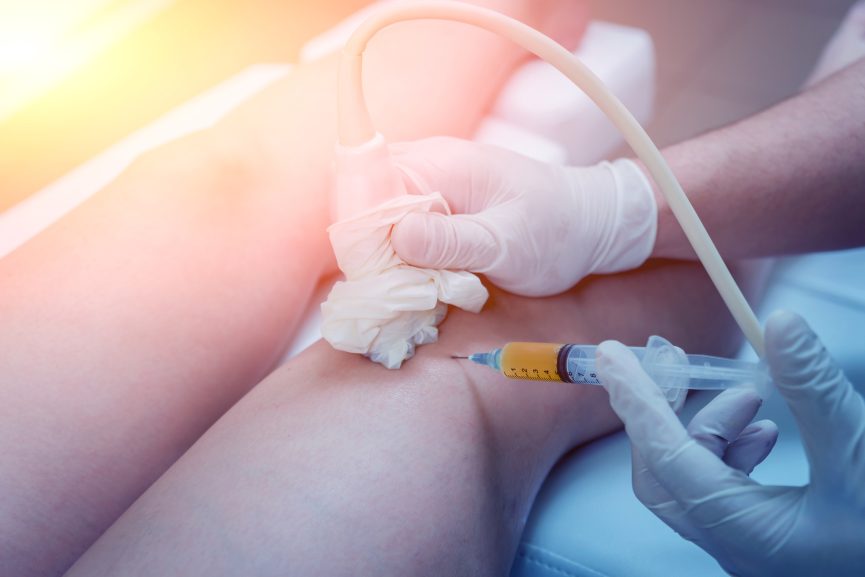If you live an active lifestyle, chances are you have experienced some of the most common athletic injuries for at least a short time. Things like RICE (Rest Ice Compression Elevation) and small-muscle strengthening exercises will usually make the pain from these injuries go away in a short time. For many, however, the pain lasts long after their initial injury.
Millions of current and former athletes experience long-term muscle and ligament pain. Some of the common places to experience chronic muscle and ligament pain are the shoulders, elbows, knees, and ankles. There are a lot of treatment options, but what can work the best?
If you’ve suffered a muscle or ligament injury that just won’t go away, PRP therapy might be the solution! Learn more about platelet-rich plasma therapy here.
The Costs of Muscle Injury
Getting hurt is not cheap.
According to the CDC, the total cost of getting injured costs Americans over 4 trillion dollars. That averages out to over $10,000 per person every single year.
Combined in that figure are spending on treatment, loss of work productivity, and loss of quality of life. A long-term injury is no joke and can cost you your valuable time, money, and effort.
Causes of Lingering Injury Pain
Long-term muscle or ligament injury pain is believed to be the result of nerve damage. This nerve damage can be debilitating and handicaps mobility. Simple things like walking, picking boxes up, or even getting out of bed become chores thanks to chronic pain.
The Recovery Process
Muscle and ligament injuries can take forever to heal from. This is because the recovery process is long and can be made even longer because of reinjuries. Worse yet, pain can last long after the recovery process is complete.
There are several ways to deal with chronic muscle pain including medication, physical therapy, and surgery. For many, these options either don’t work or are just not feasible. If none of these options can work or has worked for you, PRP therapy could be the answer you’re looking for.
What Is PRP Therapy?
Platelet-rich plasma (PRP) therapy is a regenerative medicine tool that helps heal chronic pain and injury. PRP therapy involves the use of platelets (protein-rich blood plasma) to facilitate and reignite the body’s healing process. The platelets are injected directly into the affected area and the entire process takes no longer than an hour to complete.
Why Use PRP Therapy?
There are numerous benefits to opting for PRP therapy for ligament injuries.
If you are suffering from pain in your knees, shoulders, ankles, or neck, PRP therapy is the solution you are looking for. PRP therapy reduces the inflammation caused by injuries to these areas and allows you to move pain-free again. PRP encourages new growth in the affected areas by strengthening your body’s natural repair process.
PRP therapy also has growing clinical evidence for its effectiveness and is even highly touted by professional athletes. Stars in the NFL, MLB, and NBA have used PRP therapy for muscle injuries.
It’s not just athletes from the big 3 leagues that have taken a liking to PRP therapy. Soccer players, Olympic runners, and professional hockey players have all used PRP therapy to heal their injuries. Even tennis superstar Rafael Nadal has used it to rehabilitate his knee.
PRP Therapy vs Other Treatments
Compared to a variety of other pain treatments, PRP therapy has several advantages. Let’s weigh some of those other options against PRP therapy.
Over-the-counter pain relievers such as Ibuprofen, Acetaminophen, and NSAIDs are often used to treat chronic athletic injury pain. These medications may provide initial relief but can have waning effectiveness over time because of their required frequent usage.
Prescription-grade pain killers are often opioids. Opioids are powerful drugs that can lead to unintended consequences, such as addiction. Drugs like Oxycodone, Morphine, and Hydrocodone can be highly addictive and come with a laundry list of potential side effects.
Surgery can be an invasive and costly solution to chronic muscle pain. Surgery often takes months to prepare for and may require an entirely separate rehabbing component post-operation. Invasive surgery can also lead to a bevy of complications.
Physical therapy can be an effective long-term treatment against chronic pain but is both costly and time-consuming. Rehab programs take weeks or months to complete and if little progress is made, will ultimately be a waste of time. If you don’t have insurance or a plan that covers physical therapy, you’ll be stuck paying a pretty penny.
PRP therapy is a simple site injection that will provide both immediate and long-term pain relief. For most people, just a single injection is all that is needed. PRP is non-invasive, poses no risk for addiction, and requires no long-term rehabilitation once treatment is completed.
Are There Any Drawbacks to PRP Therapy?
PRP therapy is safe. The procedure involves the use of your own blood, so there is no risk that your body will reject it like a foreign agent.
With that being said, some potential side effects come with all site injections. Like all other needle injections, there is a potential risk for bleeding, damage to local tissue, and infection.
PRP therapy poses no more additional risk than any other type of injection treatment. As with any medical treatment, you should consult your primary care physician before making any decision.
Don’t Wait, Become Pain-Free
Long-term injury muscle or ligament pain doesn’t have to last forever. PRP Therapy offers a safe, non-surgical, and non-invasive way of dealing with your chronic pain.
Get started on your journey towards becoming pain-free by contacting our team at Rejuvenate Your Health today.

